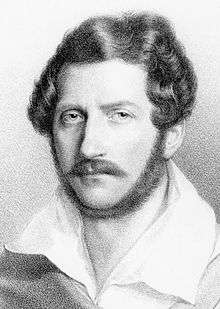Il castello di Kenilworth
Il castello di Kenilworth (or, under its original name in 1829, Elisabetta al castello di Kenilworth)[1] is a melodramma serio or tragic opera in three acts by Gaetano Donizetti. Andrea Leone Tottola wrote the Italian libretto after Victor Hugo's play Amy Robsart (1828) and Eugene Scribe's play Leicester, both of which following from Scott's novel Kenilworth (1821). Daniel Auber composed another opera on the same subject, Leicester, ou Le chateau de Kenilworth in 1823.
This opera was the first of Donizetti's excursions into the Tudor period of English history, and it was followed in 1830 by Anna Bolena, (which was based on the life of Ann Boleyn, the second wife of King Henry VIII), then by Maria Stuarda (named for Mary, Queen of Scots) which appeared in different forms in 1834 and 1835. All represented the interests (even obsessions) of many Italian composers of the era, Donizetti's included, in the character of Elizabeth I, whose life he was to explore further in 1837 in his opera Roberto Devereux (named for a putative lover of Queen Elizabeth I.) The leading female characters of the operas Anna Bolena, Maria Stuarda, and Roberto Devereux are often referred to as the "Three Donizetti Queens."
As Elisabetta al castello di Kenilworth the opera received its first performance on 6 July 1829 at the Teatro San Carlo, Naples and, in a revised version at the same house, as Il castello di Kenilworth on 24 June 1830.[1]
Roles

| Role | Voice type | Premiere Cast, 6 July 1829 (Conductor: Nicola Festa) |
|---|---|---|
| Elisabetta, Queen of England[2] | soprano | Adelaide Tosi |
| Roberto Dudley, Earl of Leicester | tenor | Giovanni David |
| Amelia Robsart, his secret consort | soprano | Luigia Boccabadati |
| Warney | baritone | Berardo Winter |
| Lambourne | bass | Gennaro Ambrosini |
| Fanny | mezzo-soprano | Virginia Eden |
| Knights of the queen, domestic servants of Leicester, guards, soldiers, people | ||
Synopsis
- Time: The reign of Queen Elizabeth I
- Place: Kenilworth Castle
It is announced that Queen Elizabeth is to visit Kenilworth, the Earl of Leicester's castle. Leicester is a favourite of the Queen, but now has a new bride, Amelia Robsart, with whom he is in love. Fearing the Queen's displeasure, he asks his servant Lambourne to arrange for Amelia to be hidden until Elizabeth departs. Amelia is taken to a small cell in the castle by Leicester's equerry, Warney. He then tries to seduce her and tells that she has been placed there because her husband no longer loves her. When Amelia rejects his advances, Warney vows revenge.
Amelia manages to escape from the cell and in a secret garden of the castle encounters the Queen. She tearfully tells the Queen about her troubles with Leicester, whom she believes has betrayed her. The Queen goes to Leicester and Warney angrily demanding an explanation. Leicester reveals his marriage with Amelia to the Queen who becomes even more angry and dismisses him.
Warney, still desiring revenge, tries to poison Amelia, but is foiled by her faithful servant, Fanny. In the end, Elisabeth orders the arrest of Warney, pardons Leicester and Amelia, and approves their marriage to the jubilation of all. [3]
Recordings
| Year | Cast (Queen Elisabeth I, Amelia Robsart, Leicester, Warney) |
Conductor, Opera House and Orchestra |
Label[4] |
|---|---|---|---|
| 1977 | Janet Price, Yvonne Kenny, Maurice Arthur, Christian Du Plessis |
Alun Francis, Philomusica of London and the Opera Rara Chorus (Recording of a performance in the Collegiate Theatre, London as part of the Camden Festival) |
Audio CD: MRF Records Cat: MRF 143-S |
| 1989 | Mariella Devia, Denia Mazzola (Gavazzeni), Jozef Kundlák, Barry Anderson |
Jan Latham-Koenig, Radio Televisione Italiana Orchestra and Chorus |
Audio CD: Ricordi/Fonit Cetra Cat: RFCD 2005 |
References
Notes
Cited sources
- Ashbrook, William and Sarah Hibberd (2001), in Holden, Amanda (Ed.), The New Penguin Opera Guide, New York: Penguin Putnam. ISBN 0-14-029312-4. pp. 224 – 247.
- Casaglia, Gherardo, "6 Luglio 1829", Almanacco Amadeus. Accessed 22 September 2009.
- Gelli, Piero (ed.) (2007), "Elisabetta al castello di Kenilworth", Dizionario dell'Opera, Baldini Castoldi Dalai. ISBN 88-6073-184-4. Accessed online 22 September 2009.
Other sources
- Allitt, John Stewart (1991), Donizetti: in the light of Romanticism and the teaching of Johann Simon Mayr, Shaftesbury: Element Books, Ltd (UK); Rockport, MA: Element, Inc.(USA)
- Ashbrook, William (1982), Donizetti and His Operas, Cambridge University Press. ISBN 0-521-23526-X
- Ashbrook, William (1998), "Elisabetta al castello di Kenilworth (1829)", Opera Quarterly, 1998; 14, pp. 116 – 119.
- Ashbrook, William (1998), "Donizetti, Gaetano" in Stanley Sadie (Ed.), The New Grove Dictionary of Opera, Vol. One. London: MacMillan Publishers, Inc. ISBN 0-333-73432-7 ISBN 1-56159-228-5
- Black, John (1982), Donizetti’s Operas in Naples, 1822—1848. London: The Donizetti Society.
- Loewenberg, Alfred (1970). Annals of Opera, 1597–1940, 2nd edition. Rowman and Littlefield
- Osborne, Charles, (1994), The Bel Canto Operas of Rossini, Donizetti, and Bellini, Portland, Oregon: Amadeus Press. ISBN 0-931340-71-3
- Sadie, Stanley, (Ed.); John Tyrell (Exec. Ed.) (2004), The New Grove Dictionary of Music and Musicians. 2nd edition. London: Macmillan. ISBN 978-0-19-517067-2 (hardcover). ISBN 0-19-517067-9 OCLC 419285866 (eBook).
- Weinstock, Herbert (1963), Donizetti and the World of Opera in Italy, Paris, and Vienna in the First Half of the Nineteenth Century, New York: Pantheon Books. LCCN 63-13703
